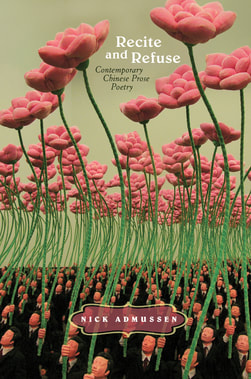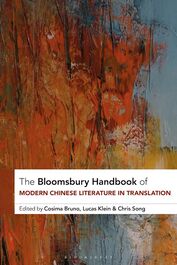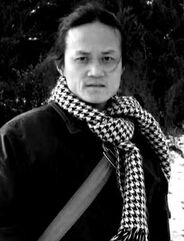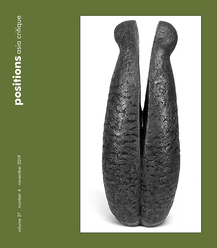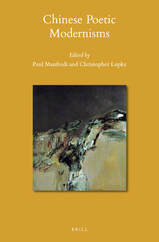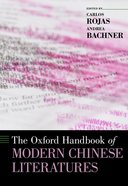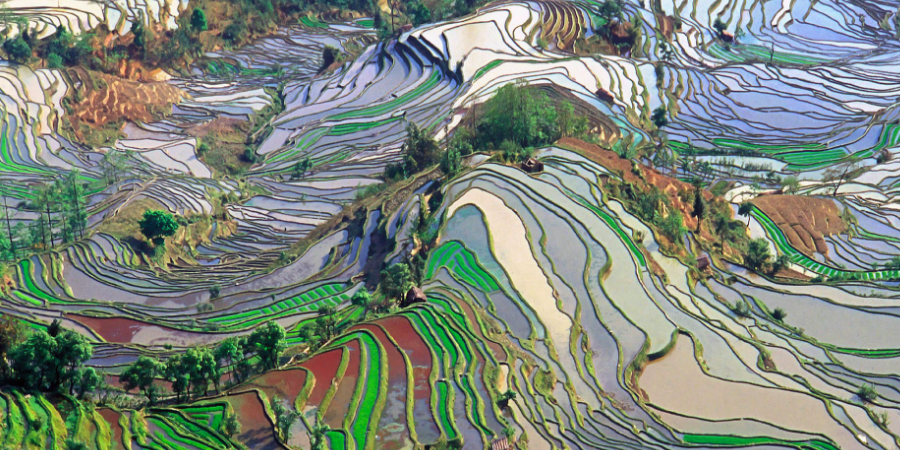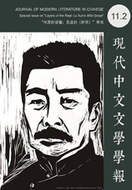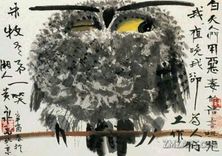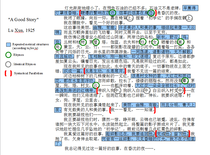Recite and Refuse: Contemporary Chinese Prose Poetry
|
Chinese prose poetry today is engaged with a series of questions that are fundamental to the modern Chinese language: What is prose? What is it good for? How should it look and sound? Millions of Chinese readers encounter prose poetry every year, both in the most official of state-sponsored magazines and in the unorthodox, experimental work of the avant-garde. Recite and Refuse makes their answers to our questions about prose legible by translating, surveying, and interpreting prose poems, studying the people, politics, and contexts that surround the writing of prose poetry.
Authors discussed in the book include Ke Lan 柯蓝, Guo Feng 郭风, Liu Zaifu 刘再复, Ouyang Jianghe 欧阳江河 and Xi Chuan 西川, in addition to many others. Scholars have called the book "innovative, insightful, and theoretically creative"; "a wholly original work of scholarship that is set to rewrite the paradigm through which we consider modern and contemporary Chinese prose poetry." In The China Journal, Michel Hockx wrote that he "enjoyed every single page of this book." It was also reviewed generously by Wang Pu in the China Quarterly here, and by Todd Foley in the FLSC, here. I did an interview about it for NBN here, and you can order it from the Hawaii University Press here. |
Selected Essays
|
"Translations as Versions in Modern Chinese Literature" tries to identify and define the nature of a translation by engaging with the fluidity and plasticity of translation practice in 20th century China. By reading the many competing texts, in both English and Chinese, of Lao She's novel Rickshaw Boy, and by examining the part-imitative and part-translative poetic practice of Li Jinfa, the essay argues that a translation is a version, in Christopher Plaisance's sense, of an original. This is true whether a translation is heavily transformative and performative, in the case of the film versioners of Thailand (who performed Thai-language dialogue for audiences as foreign movies played in the background), or if translations claim to be highly reproductive, as in the case of some textual transmissions in the classical Chinese tradition. This essay is part of the Bloomsbury Handbook of Modern Chinese Literature in Translation, edited by Cosima Bruno, Lucas Klein and Chris Song.
|
|
"The Elegaic Transnational: Mourning Chinese Poetry" asks fundamental questions about world literature from a post-pandemic context of constrained travel, incomplete transculturation, and insufficient cultural contact. It does so by asking why and how to translate the poetry of Hei Guang, who died in Shenzhen in 2017, if the translator cannot go circulate in Hei Guang's community, understand his life and work, and perform thick translation. The essay concludes that world literature is a kind of severed and incomplete entrance to the intimacy and joy of transcultural work, and that one might appropriately and acontextually translate Hei Guang not because the practice itself represents transcultural contact, but out of a sense of mourning for its lack. This essay is part of the special issue Elegy Today, edited by Adele Bardazzi, Roberto Binetti and Jonathan Culler.
|
|
"Virus as Hermeneutic: from Gu Cheng to Xie Ye" theorizes the potential uses and limitations of describing a text as "viral." It reads the fantasies of genius and gendered violence in the reception of the poet Gu Cheng, and argues that these fantasies are made circulable in part by suppressing the experience of his wife, Xie Ye, whom he killed in 1993, much as viruses evolve to suppress external qualities that identify them as alien to the body. On the strength of Deleuze and Guattari's argument that the rhizome cannot be encompassed but instead only extended through rupture, the essay then reads Xie Ye's prose compositions "Games" and "Your Name Is Little Mu'er," finding them to contain stories that can travel and concepts whose circulation may contribute to antipatriarchal goals. The piece concludes by arguing that the metaphor of the virus reveals the position of the scholar who reproduces texts for study, and that thinking through the virus implicates scholars in the ethics and pragmatics of spreading texts.
|
|
I have an essay titled "Embodiment in the Translation of Chinese Poetry" in the volume Chinese Poetry and Translation: Rights and Wrongs, edited by Maghiel van Crevel and Lucas Klein. My essay examines recent Chinese-English translations of contemporary poetry that use strategies other than lexical and grammatical equivalence (word for word, sentence for sentence). To translate a poem with respects to its effects, communities, and politics, I argue, one must assess the embodiment of the translation--the translation's effect on the bodies of the reader (rhythm, illustration, activist reading) as well as on the body of the author (consensuality). It ends by discussing the impact of the digital turn on embodied and equivalent translations. Rights and Wrongs is free to read in its entirety and has some fantastic work in it. Highly recommended!
|
|
My essay in Christopher Lupke and Paul Manfredi's volume Chinese Poetic Modernisms is called "Network Analysis as a Modernist Intervention: the Case of Chinese Poetry Readings." It theorizes the ideological underpinnings of network theory to be resolutely modern, then rereads Franco Moretti's Distant Reading to show the limitations of modernist hermeneutics when they are applied to non-modern or anti-modern texts. The piece then invents an IMDB-like structure to attempt the quantification and data analysis of Chinese poetry readings, which feature role-switching, geographical specificity, and hierarchies of age and fame. Poetic Modernisms was reviewed warmly by Joanna Krenz at MCLC, who said this piece was "a rare example of an approach in which Chinese literature—and Chinese Studies—become not just a passive recipient but a source of more broadly applicable methods that may serve researchers beyond the field of sinology."
|
|
I was lucky enough to attend an international poetry reading in Taiwan in 2016, and what I saw and learned there provoked this essay: "Forms of World Literature and the Taipei Poetry Festival." World literature, it argues, circulates in very particular forms: the anthology, the work of literary criticism, and the international writers' festival, among others. I compare anthologies (like the Ecco anthology) to literary criticism (like Emily Apter's work) to the Taipei festival to see which forms of world literature are most equitable, most open, and least boring. Click on the essay title here (and below) to download a PDF. |
|
My essay in the Oxford Handbook of Modern Chinese Literatures is called "Genre Occludes the Creation of Genre: Bing Xin, Tagore, and Prose Poetry." It studies the way that Bing Xin helped found the genre of prose poetry by using modernist beliefs about the form and content of poetry to translate the work of Rabindranath Tagore, and argues that the stable presence of a genre prevents us from visualizing the origin of that genre. It also shows what I think is a standard genealogy for many qualities of Chinese literature -- forged in the very act of transnational borrowing, neither beholden to source texts nor ignorant of them.
|
|
I wrote a polemic for the Critical Flame called "Six Proposals for the Reform of Literature in the Age of Climate Change." It makes the argument that a revolution in literary content is probably insufficient to respond to our present climate crisis, and lays out potential changes in literary form and practice that may have better results. It is modeled on Hu Shi's 1916 essay about Chinese language reform. It was translated into Chinese as "关于气候变化时代文学改革的六点建议" and republished at Chinadialogue.
|
|
I edited and contributed to an issue of the Journal of Modern Literature in Chinese called Lu Xun's Yecao: Layers of the Real. The contributors are all trying to understand 《野草》, sometimes translated Wild Grass, Lu Xun's 1927 collection of prose, poems, and prose poems. My introduction to the issue, "The Title of Yecao," takes up the question of the translation of the book's title. My full-length essay, "The Poetics of Hinting," sets itself the difficult task of understanding the collection as a whole, arguing that it is structured as a long, slowly unfolding literary hint. Click on the essay titles to download PDFs. |
|
Before I completed Recite and Refuse, I published some of its most basic arguments in an essay called "Trading Metaphors: Chinese Prose Poetry and the Reperiodization of the Twentieth Century." By understanding periodization as a metaphor -- useful only when it identifies similarities between distinct texts -- the essay challenges the standard narrative of the history of prose poetry, identifying a sea change in work produced before and after 1949. The piece also includes translations and readings of poems by Shen Yinmo 沈尹默, Liu Bannong 刘半农, Ke Lan 柯蓝, and Huang Yongyu 黄永玉. |
|
My first full-length research essay was called "A Music for Baihua: Lu Xun's Wild Grass and 'A Good Story.'" It carefully reads the prosody of a single prose poem, and then contextualizes the poem's rhythms and structures in early twentieth-century Chinese literature. It concludes that the poem innovates musics and meters intended to aestheticize the brand-new language that we now call Modern Standard Chinese. The methods of the poem (see the adjacent annotation) repeat continually in later Chinese poetry and lyric prose.
|
Copyright © 2016
